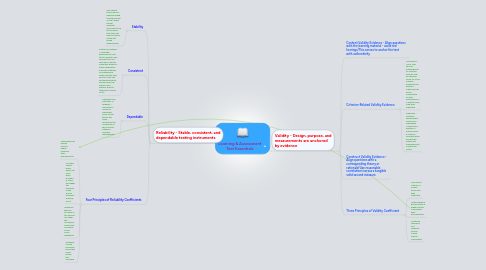
1. Validity - Design, purpose, and measurements are anchored by evidence
1.1. Content Validity Evidence - Align questions with the learning material - avoid red herrings/This serves to anchor the test with authenticity
1.2. Criterion-Related Validity Evidence
1.2.1. Concurrent - Use a valid second measurement to compare side-by-side to establish score-to-score numeric evidence/The external criteria serves as the cornerstone for test effectiveness – is usually more valid than predictive
1.2.2. Predictive - Question development focused on previewing current skills, abilities or action scores in order to forecast future scores/This entails two measurements, current and future
1.3. Construct Validity Evidence - Align questions with a corresponding theory or rationale/Use reasonable correlations versus a tangible valid second measure
1.4. Three Principles of Validity Coefficient
1.4.1. Concurrent criterion is usually more valid than predictive
1.4.2. Heterogeneous groups result in higher validity coefficients than homogeneous
1.4.3. Criterion’s relevance and reliability factors impact validity coefficients
2. Reliability - Stable, consistent, and dependable testing instruments
2.1. Stability
2.1.1. Test-Retest time intervals - determine high (shorter period) or low (longer period) reliability association/Use time interval that tests but does not place student at undue disadvantage
2.2. Consistent
2.2.1. Internal consistency – using two approaches in one test to question one concept/Can use split-half as well as Spearman-Brown or Kuder-Richardson formulaic methods for measuring a single concept that involves “only one test administration and are free from memory and practice effects” (Kubiszyn & Borich, 2010).
2.3. Dependable
2.3.1. Alternate-form estimates of reliability – administer a couple of equivalent forms of the test to the same group/Use the correlation of the scores to establish question dependability
2.4. Four Principles of Reliability Coefficients
2.4.1. Heterogeneous groups result in higher reliability than homogeneous
2.4.2. “All other factors being equal, the more items included in a test, the higher the reliability of the scores” (Kubiszyn & Borich, 2010).
2.4.3. Questions that are too easy or too difficult can skew the correlation coefficient and result in low score reliabilities.
2.4.4. Authentic scoring minimizes errors that could render test unreliable
